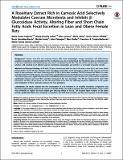Por favor, use este identificador para citar o enlazar a este item:
http://hdl.handle.net/10261/152088COMPARTIR / EXPORTAR:
 SHARE SHARE
 CORE
BASE CORE
BASE
|
|
| Visualizar otros formatos: MARC | Dublin Core | RDF | ORE | MODS | METS | DIDL | DATACITE | |

| Campo DC | Valor | Lengua/Idioma |
|---|---|---|
| dc.contributor.author | Romo Vaquero, María | es_ES |
| dc.contributor.author | Selma, María Victoria | es_ES |
| dc.contributor.author | Larrosa, Mar | es_ES |
| dc.contributor.author | Obiol, María | es_ES |
| dc.contributor.author | García-Villalba, Rocío | es_ES |
| dc.contributor.author | González-Barrio, Rocío | es_ES |
| dc.contributor.author | Issaly, Nicolas | es_ES |
| dc.contributor.author | Flanagan, John | es_ES |
| dc.contributor.author | Roller, Marc | es_ES |
| dc.contributor.author | Tomás Barberán, Francisco | es_ES |
| dc.contributor.author | García-Conesa, María Teresa | es_ES |
| dc.date.accessioned | 2017-06-27T11:44:58Z | - |
| dc.date.available | 2017-06-27T11:44:58Z | - |
| dc.date.issued | 2014-04-14 | - |
| dc.identifier.citation | PLoS ONE 9(4): e94687 (2014) | es_ES |
| dc.identifier.issn | 1932-6203 | - |
| dc.identifier.uri | http://hdl.handle.net/10261/152088 | - |
| dc.description.abstract | [Background] Carnosic acid (CA) and rosemary extracts (RE) show body-weight, energy metabolism and inflammation regulatory properties in animal models but the mechanisms are not yet understood. Gut microbiota plays an important role in the host metabolism and inflammatory status and is modulated by the diet. The aim of this research was to investigate whether a RE enriched in CA affected caecum microbiota composition and activity in a rat model of genetic obesity. | es_ES |
| dc.description.abstract | [Methods and Principal Findings] A RE (40% CA) was administered with the diet (0.5% w/w) to lean (fa/+) and obese (fa/fa) female Zucker rats for 64 days. Changes in the microbiota composition and β-glucosidase activity in the caecum and in the levels of macronutrients and short chain fatty acids (SCFA) in feces were examined. The RE increased the Blautia coccoides and Bacteroides/Prevotella groups and reduced the Lactobacillus/Leuconostoc/Pediococccus group in both types of animals. Clostridium leptum was significantly decreased and Bifidobacterium increased only in the lean rats. β-Glucosidase activity was significantly reduced and fecal fiber excretion increased in the two genotypes. The RE also increased the main SCFA excreted in the feces of the obese rats but decreased them in the lean rats reflecting important differences in the uptake and metabolism of these molecules between the two genotypes. | es_ES |
| dc.description.abstract | [Conclusions] Our results indicate that the consumption of a RE enriched in CA modifies microbiota composition and decreases β-glucosidase activity in the caecum of female Zucker rats while it increases fiber fecal elimination. These results may contribute to explain the body weight gain reducing effects of the RE. The mutated leptin receptor of the obese animals significantly affects the microbiota composition, the SCFA fecal excretion and the host response to the RE intake. | es_ES |
| dc.description.sponsorship | This project was financed by the Spanish Centre for the Development of Industrial Technology (CDTI) as part of the project SENIFOOD, which belongs to the CENIT subvention program (Ref: CEN-20091006). This work was also supported by the Project Consolider Ingenio 2010, CSD2007-00063 (Fun-C-Food) and by the Seneca Foundation of the Region of Murcia, Spain (Group of Excellence GERM 06 04486 and 05556/PI/04). | es_ES |
| dc.language.iso | eng | es_ES |
| dc.publisher | Public Library of Science | es_ES |
| dc.relation.isversionof | Publisher's version | es_ES |
| dc.rights | openAccess | es_ES |
| dc.title | A Rosemary Extract Rich in Carnosic Acid Selectively Modulates Caecum Microbiota and Inhibits β-Glucosidase Activity, Altering Fiber and Short Chain Fatty Acids Fecal Excretion in Lean and Obese Female Rats | es_ES |
| dc.type | artículo | es_ES |
| dc.identifier.doi | 10.1371/journal.pone.0094687 | - |
| dc.description.peerreviewed | Peer reviewed | es_ES |
| dc.relation.publisherversion | https://doi.org/10.1371/journal.pone.0094687 | es_ES |
| dc.rights.license | https://creativecommons.org/licenses/by/4.0/ | es_ES |
| dc.contributor.funder | Centro para el Desarrollo Tecnológico Industrial (España) | es_ES |
| dc.contributor.funder | Ministerio de Economía y Competitividad (España) | es_ES |
| dc.contributor.funder | Fundación Séneca | es_ES |
| dc.relation.csic | Sí | es_ES |
| oprm.item.hasRevision | no ko 0 false | * |
| dc.identifier.funder | http://dx.doi.org/10.13039/501100003329 | es_ES |
| dc.identifier.funder | http://dx.doi.org/10.13039/100007801 | es_ES |
| dc.identifier.funder | http://dx.doi.org/10.13039/501100001872 | es_ES |
| dc.identifier.pmid | 24733124 | - |
| dc.type.coar | http://purl.org/coar/resource_type/c_6501 | es_ES |
| item.fulltext | With Fulltext | - |
| item.languageiso639-1 | en | - |
| item.openairecristype | http://purl.org/coar/resource_type/c_18cf | - |
| item.openairetype | artículo | - |
| item.cerifentitytype | Publications | - |
| item.grantfulltext | open | - |
| Aparece en las colecciones: | (CEBAS) Artículos | |
Ficheros en este ítem:
| Fichero | Descripción | Tamaño | Formato | |
|---|---|---|---|---|
| 2014_Rosemary_microbiota_PlosONE.pdf | 390,34 kB | Adobe PDF |  Visualizar/Abrir |
CORE Recommender
PubMed Central
Citations
20
checked on 09-abr-2024
SCOPUSTM
Citations
56
checked on 24-abr-2024
WEB OF SCIENCETM
Citations
48
checked on 26-feb-2024
Page view(s)
349
checked on 24-abr-2024
Download(s)
176
checked on 24-abr-2024

